EARLY HERNANDO COUNTY HISTORYCentralia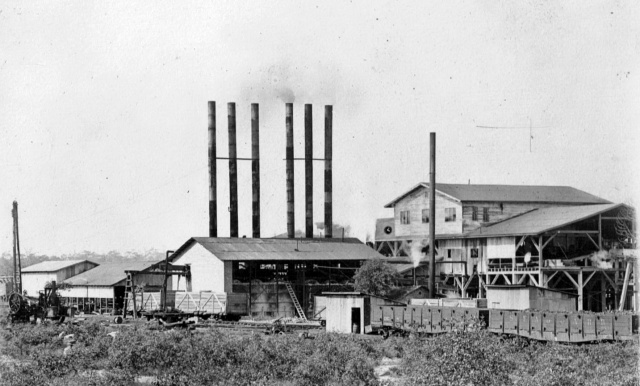 Historical Memories of Centralia in Hernando County, Florida
Centralia Florida was named after a lumbering and agriculture town by the same name in Wisconsin. Some of the people that worked at the Hernando County saw mill lived in a settlement called Wiscon, about 5 miles due west of Brooksville. These people came from Wisconsin and Connecticut, hence, they called their settlement Wiscon. And today it is still marked by an important survey monument on surveyors charts with a U. S. geodetic bench marker which surveyors use quite frequently when taking geographic bearings in the west side of Hernando County. The Wiscon Road intersects State Road 50 about half way between Brooksville and Weeki Wachee Springs. Centralia was a short lived “boom town” that was born in 1910 and died in 1922, and was located 4 1/2 miles north of Weeki Wachee Springs and east of what we know today as U. S. 19 Highway, just north of Tooke Lake. Mr. Stan Weston, a Florida state farm forester, once wrote an article several years ago entitled, “The Death of a Forest and Town,” which dealt with Centralia. With permission we borrow parts of the story to relate the historical memories to you. “Seventy some odd years ago, a sea of virgin timber blanketed our state. Longleaf and slash pine, two and three foot in diameter, gave forth of their resinous gum, to tar the lines and shrouds, and caulk the planks and lapstrakes op the worlds navies, and the turpentine was used for medicinal purposes, creating the first and largest industry in Florida naval stores. The low lands and swamps contributed the greatest volume, highest grade, fastest growing, durable, red tide water cypress to be found any where in the United States of America. This wealth of timber seemed inexhaustible and lured men and industry from all corners of the earth. Towns blossomed, nourished by the whine of the circular and band saw. Meanwhile, further west in the United States another boom had long since blossomed and was beginning to fade. A non-renewable resource, silver, gold, and other metals were running out. Once prosperous towns were being deserted. Sage brush, chaparral and desert sands were reclaiming their own as the flow op valuable yellow dust from mother earth trickled and stopped. Still the sawmills throughout the southeast whined louder and louder. No thought was given to the future of replenishing the forest. Was not this blanket of forest inexhaustible? Wasn’t it a waste land of wilderness, jungle, something to be removed so that ‘civilization’ might advance? Leave seed trees, plant new trees, seedlings,—ridiculous they thought. Never would this sea of virgin timber be exhausted. How wrong they were! In this atmosphere the town of Centralia, in west Hernando County, was born. The mill in 1911 had an estimated daily cut capacity of one hundred thousand board feet. This was a double band mill that to this day has not been surpassed in volume or efficiency. Centralia’s life blood flowed from this mill and when the timber was cut out, the stream dried up and this thriving town of some 1,500 to 1,800 persons faded into oblivion. The prosperous stores, commissary, grocery and dry goods and hardware, carried more stock than any retail store in metropolitan Tampa or Jacksonville. The store room had a capacity of four freight car loads of merchandise. There was a standard gauge railroad that ran west from Brooksville through the settlement of Wiscon to Tooke Lake. Just south of Centralia and the Turner Lumber Company had a narrow gauge logging tram railroad throughout their logging areas but never connected to the standard gauge line on account of difference in wheel size. Instead there was a loading and transfer platform between the two railroad terminus. A United States post office was established at Centralia 10 June 1910 and mail service was discontinued 11 December 1922 according to postal records in Brooksville. It was not unusual to see the following merchandise delivered by rail for the commissary: 100 barrels of flour, 20 barrels of sugar, 10 barrels of grits, 10 barrels of meal, 100 cases of tomatoes and corn, 10 bags of dry lima beans and navy beans, 50 bags of potatoes, 500 cases of soft drinks, and 10 – 45 lb. cans of oil sausage. This commissary store was owned by Mr. Gamble. It was a huge store that supplied the groceries, dry goods and hardware needs of the town, and kept open from 6 am until 10 pm, and was well patronized by the people talking around the cracker barrel of the days happenings and subjects common of those days. The largest log cut at Centralia was in 1912. No record was ever made of the board feet in the entire tree. The butt cut had to be quartered by blasting before it could be moved. The top twenty feet was left on the flat car for the people to view. It scaled 5,476 boardfeet, enough to build a modern home. As the ghost towns of the western gold and silver era faded from view, so Centralia died as the forest, and its renewable timber disappeared. Today just a few miles north of Weeki Wachee Springs amid the black jack pine and palmetto lie the mute foundations of the Centralia settlement and mill, the once proud master of the cypress swamp. In the 1960s the Turner Lumber Co., the owners of the timber land in the Centralia days, put their heavy equipment to work here preparing the soil for a new crop of trees. Now it is slash pine. Nowadays this type of pine has been proven by its wide adaptability to the varied soil and moisture conditions of western Florida, capable of producing the greatest volume of timber in the shortest time. What a story could we tell, if these early timber men had planted a tree for each that they harvested. Time alone will paint this picture. The last 48 years, about 7 million trees were planted in Hernando and Pasco counties. This past few years close to 2 million seedling pines were set out. The Turner Lumber Co. planted about 1 million alone. The impact of such a planting program by private land owners will be keenly felt by our economy in the not too distant future. In conclusion I would like to say, “We may not raise another Centralia but we can and must save our forests. Many logging companies now employ registered foresters to protect growing stock for the future harvests. Foresters assist landowners in profitably managing those stands of timber that still exist. They show woodland owners how to sell trees, but save their forest.” This concludes our historical topic and the Hernando Historical Museum hopes you have enjoyed the selected subject. Thank you very much for listening and please do come again and bring along friends. Centralia: A Logging Town That Ran Out of Logs (1977)
This article appeared in the St. Petersburg Times on April 11, 1977. A larger version of this photo, with a caption, is here. By WILFRED T. NEILL In several previous articles of this series I’ve mentioned our numerous “ghost towns”—settlements that have long since vanished. One of the most interesting ghost towns of our area is Centralia, six miles north of Weeki Wachee on the west side of U. S. 19. Centralia was a logging town first settled in 1910. It was named by Edgar Roberts after his home town of Centralia, Ill. [see note below] Roberts and his brother owned the Central Cypress Lumber Co., which cut giant cypress, and sometimes other timbers, in Hernando County and vicinity. The brothers had the logging town built primarily to provide housing and services for their employees. Centralia grew to be a sizable community, with about 1,500 men, women and children. (By way of contrast, the Hernando County seat, Brooksville, had only 500 inhabitants at the time.) Centralia’s main street was of sand, covered with sheets of cypress bark, and the sidewalks were made of cypress slabs. Small white-washed dwelling houses bordered the main street on each side. Other houses were scattered about, most of them in the shade of liveoak trees. There was also a one-room schoolhouse, with about two dozen pupils whose parents worked for the logging company. The school likewise accepted a few children from nearby families who were not involved with sawmilling The teacher usually was a young woman at the start of her career, And there was a boarding house, the Centralia Hotel. It was occupied mostly by bachelors who worked for the logging company, but it also took in guests who happened to be passing through that part of Florida. There was a restaurant, the Hungry None, which served meals at almost any time of day or night. There was a drugstore, a non-denominational church, and a movie house called the Flicker Palace. But Centralia’s best-known building was George Gamble’s commissary. The Tampa Northern Railroad came into town, hauling logs in and lumber out; and Gamble could use the railway to bring in goods for sale in his store. Occasionally he’d receive as many as four freight carloads of goods at one time. Gamble’s commissary sold flour, cornmeal, grits, sugar, salt, coffee, seasonings, medicines, garden produce, clothing, yard goods, household utensils, tools, kerosene—everything needed by the loggers, sawmillers and their families. In fact, Gamble imported not only necessities but even luxuries, including Greek delicacies such as feta cheese, olive oil, roka and black Calamata olives. Indeed, the commissary was better stocked than most stores in larger cities of the Gulf coast. Quite a few people came to Centralia from other settlements, to buy from Gamble’s. At his own expense Edgar Roberts built a branch railway line from Centralia to Tooke Lake, about 2 1/2 miles way. At the lake there was a turpentine still operated by Lewis S. Petteway, a close friend of the Roberts brothers. There was no turnaround at the lake, so trains backed in from Centralia to load Petteway’s turpentine. Roberts made sure that his employees’ needs were taken care of. For example, he kept a doctor on the staff. The doctor, who made his calls in a Model T, had no shortage of patients; for the loggers and sawyers suffered a good many accidents. Malaria was a problem, too. A Brooksville dentist, D. L. Heddick, was under contract with Roberts to take care of Centralia’s dental needs. Nor did Roberts overlook the necessity for fun and recreation. There were various social events, including Saturday night square dances that drew crowds from Brooksville, Dade City, Aripeka, Port Richey and several communities that have since vanished from the map. Obviously Roberts had a well-run operation. He had, in fact, the most efficient sawmill town in the area. Logs were hauled in by train, dumped into a pond and floated to the mill. Here they were loaded onto a ramp, where heavy chains pulled them into the saws. Double band saws cut the rough timber into finished boards. Power for winching and sawing was provided by four large steam boilers. One day in 1912 the Centralia sawmill received its largest log, a cypress timber that yielded 5,476 board feet of lumber. For several weeks the tree’s gigantic top was displayed on a flatcar for people to marvel at. The mill could turn out 100,000 board feet a day, and on many days it did so. But the supply of timber would not last forever. In 1917 Centralia had 160 acres of land stacked with lumber piles 15 feet high—but there were no more trees to cut. And so “Queen” Roberts, Edgar’s young daughter, pulled and tied down the cord on the big steam whistle that had so often called the sawyers to work. The whistle roared for a while, then died away. People went home, packed some possessions, and left. Centralia was dead, abandoned. In time the houses vanished, destroyed by termites and brush fires. But the float pond remains, and the ramp up which the great logs were winched, the concrete slab on which the water tank once stood, the brick foundations of the sawmill and the depot. Rails and cross-ties are gone, but the route of the Tampa Northern Railway can still be traced. Today the area is pockmarked with holes. For Centralia’s garbage pits and outhouse excavations have lately been dug into by collectors in search of old bottles and other relics. The ground is littered with scraps of glassware and chinaware, old bricks, broken tools and toys, rusted cans. The trash of 1910-17 has become the antiques of 1977. NotesEdgar Arvil Roberts (b. March 13, 1893, Paintsville, Ky.; d. Jan. 1969, Hernando County) was still living in Paintsville in 1920, so the statement above that he named Centralia for his hometown, Centralia, Illinois, may be incorrect. Roberts was appointed postmaster of Centralia on June 10, 1919. A picture of Roberts is here. An article in the Tampa Morning Tribune of Aug. 1, 1917, referred to Roberts as general manager of Central Cypress Lumber Co. of Centralia. A 1915 article referred to him as president of the Central Cypress Co. See also the web site Centralia Garden Railroad, maintained by Doug Brainard. The site has information about his garden railroad and the town of Centralia. Some of What Remains of the Centralia Mill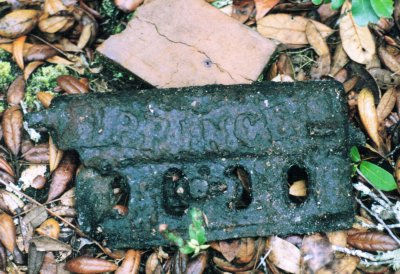
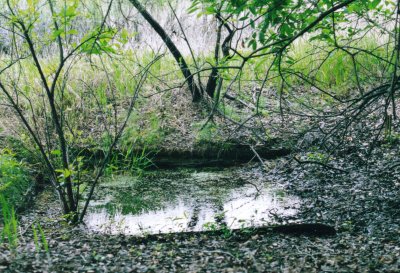
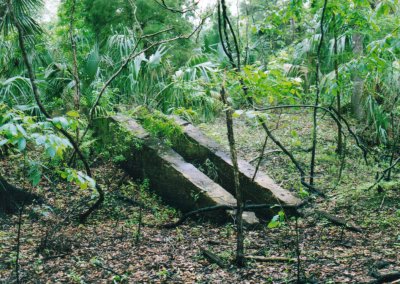

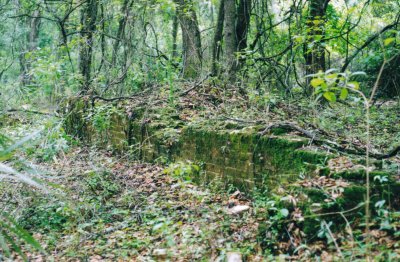
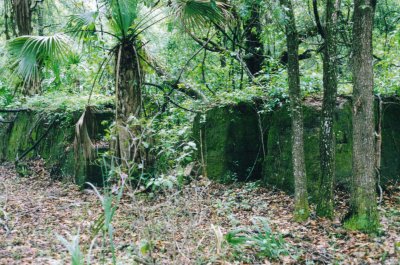
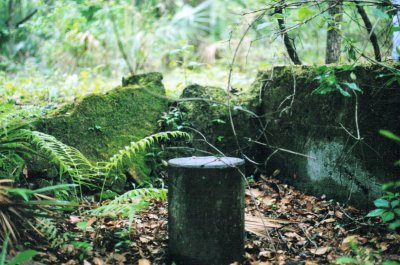
Centralia Historical MarkerThe Centralia historic marker was dedicated on Sept. 23, 2017. It is south of Centralia Road on U. S. 19. Side 1: This site was once the location of one of Florida’s largest lumber mills. As demand for insect and rot resistant cypress increased, the J.C. Turner Lumber Company began the logging of over 15,000 acres of Red Tidewater Cypress, cedar and pine in coastal Hernando County. The Turner Company financed the construction of the mill in 1910. It was known locally as the Tidewater Cypress Mill. Eighteen miles of narrow-gauge tram lines were laid through the swamp to connect the mill and logging areas to the Tampa Northern Railroad. Laborers used steam-powered skidders to transport cut logs onto railroad cars. The logs were then dumped in a pond near the sawmills. The large double-banded saws, powered by electricity generated from four steam boilers, could cut 100,000 board feet each day. The finished wood was stacked in a 160-acre drying yard for up to four years. The dried wood was sent to the planing mill to become roof shingles, lath, and construction lumber. The finished lumber was sold locally, or transported sixteen miles by rail to Brooksville, where it continued to the port in Tampa and was loaded onto ships headed to the company’s wholesale distribution yard on the Hudson River in New York. Side 2: Located a few miles north of Weeki Wachee, the “boom town” of Centralia sprang up to support the 1,200 mill workers and their families. The wealth of timber seemed inexhaustible, luring men and industry from all corners of the earth. A post office opened in 1910 followed by other businesses, including a general store, drugstore, Mrs. Varn’s Centralia Hotel, the Hungry None Restaurant, and a Greek bakery. The general store, run by George Gamble, boasted more stock than any store in larger towns like Jacksonville or Tampa. Centralia offered other amenities such as a resident doctor and dentist, schoolhouse, and community church offering Catholic and Protestant services. There were no saloons, however, as the mill’s general manager, Edgar A. Roberts, forbade drinking. Soda pop was the drink of choice. The trees were exhausted by 1917, and the mill shut down soon after. The town struggled along for a few more years, but was mostly abandoned by the 1920s. Only the foundations of this once mighty mill remain. The Turner company reseeded the land with slash pines in the 1960s. Purchased in 1985 by the Florida Fish and Wildlife Conservation Commission, the land became part of the Chassahowitzka National Wildlife Refuge. |

 The writer of the article is unknown.
The writer of the article is unknown.